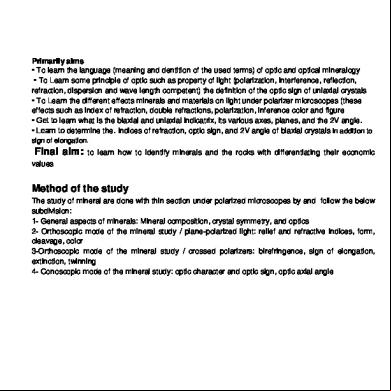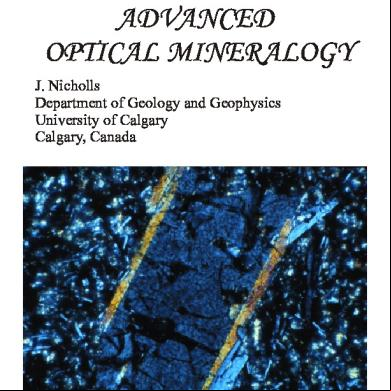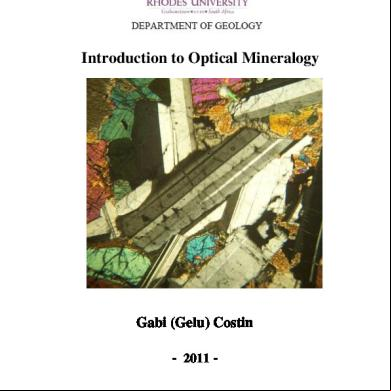Olivine Optical Mineralogy Properties 111a5v
This document was ed by and they confirmed that they have the permission to share it. If you are author or own the copyright of this book, please report to us by using this report form. Report 2z6p3t
Overview 5o1f4z
& View Olivine Optical Mineralogy Properties as PDF for free.
More details 6z3438
- Words: 761
- Pages: 6
Dari web: http://www.nslc.ucla.edu/pet/mineral_html/Olivine.html
Olivine Next Mineral
xpl 10*
ppl 20*
xpl 20*
ppl 20*
xpl 20*
ppl 5*
1. xpl 3rd order birefringence x5
2. ppl ideal crystal shape x5
3. xpl maximum birefringence x5
4. xpl extinction x5
7. ppl olivine in pyroxence x5
8. xpl olivine in pyroxence x5 group olivine system orthorhombic formula (Fe,Mg)2SiO4 optic biaxial neg / pos Too-Vee 46 - 98¡ relief.1 high pos min. index 1.636 / 1.879 color colorless, yellow pleochroism yes birefringence.1 0.033 - 0.052 cleavage no elongation yes extinction parallel angle 0¡ alteration iddingsite, chlorophaeite habit.1 subequant, anhedral (aggregates), euhedral occurence igneous (granitic, volcanic, mafic, ultramafic) meta- morphic (skarn), sedimentary TwoV 1 2 relief 3 pleochroism.2 yellow, orange birefringence 9 12 13 cleavage.2 ( {010}, {110} not seen in thin section)
dari web: http://www.brocku.ca/earthsciences/people/gfinn/minerals/olivine.htm
OLIVINE General Formula: (Fe,Mg)2SiO4
System: Orthorhombic
Sample: PT-96
Euhedral to subhedral olivine Olivine phenocrysts, phenocrysts exhibiting nd rd irregular fractures, exhibiting 2 to 3 in a plagioclase order interference colours microlite matrix Field of View = 4.0 mm, Crossed Field of View = polars 4.0 mm, plane light
Block diagram showing the relationship between the crystallographic axes and the indicatrix axes.
Optical Properties Colour Pleochroism
usually colourless, darker colours correspond to higher iron content non pleochroic
Form
generally subequant anhedral grains or aggregates in intrusive and metamorphic rocks. Equidimensional or elongated euhedral grains in volcanics
Relief RI
high positive n = 1.636-1.827 n = 1.651-1.869 n = 1.669-1.879
Cleavage
not observed
Birefringence 0.033-0.052 Interference up to third order
Twinning
not common
Colours Interference Figure Optic Sign 2V
biaxial positive or negative 46-98°
Optic Orientation
elongate grains have parallel extinction and may be either length fast or slow
Composition
minor substitution of Alteration Mn, Zn, Ca, Ni, Cr or Al for Fe and Mg
Occurrence
pure Fo (Mg-rich) is Distinguishing high birefringence, restricted to Features distinctive fracturing, lack metamorphosed of cleavage, and alteration carbonates, intermediate products. Fe-Mg olivine is common in mafic and ultramafic igneous rocks, Fe-rich olivine occurs in felsic rocks.
commonly alters to iddingsite and chlorophaeite, which are really mixtures of various minerals which cannot be identified, and serpentine. Alteration progresses from the edge and along cracks
Dari web: http://www.science.smith.edu/geosciences/petrology/petrography/olivine/olivine.html
Smith College - Geology 222b - Petrology Petrographic Data File
Olivine Property
Value
Comments Complete solid solution between Mg2SiO4 (forsterite) and Fe2SiO4 (fayalite).
Formula
(MgFe)2SiO4
Crystal System
orthorhombic
Crystal Habit
granular masses or rounded grains
Cleavage
no distinct cleavage
conchoidal fracture
Color/Pleochroism
Olive or yellowish-green in hand samples. Colorless to pale green in thin section. Weak, pale green
Can be a yellowish color when rich in iron.
pleochroism in thin section.
Optic Sign
Biaxial (-); or Biaxial (+)
2V
82-90; forsterite 46-90; fayalite
if 2V =82-90 it is forsterite and Biaxial (+) if 2V=46-90 it is fayalite and Biaxial (-) Varies depending on composition. Click here for graph.
Optic Orientation
X=b Y=c Z=a
O.A.P. = (010) Refractive Indices alpha = beta = gamma = delta = Max Birefringence
1.635-1.827 1.651-1.869 1.670-1.879 0.035-0.052 0.033 - 0.052
Elongation Extinction
parallel
Elongate crystals display parallel extinction.
Dispersion
Distinguishing Features
Colorless to olive green in thin section. Second-order interference colors. High relief. Lack of cleavage. H= 7. G = 3.22 to 4.39. Specific gravity increases and hardness decreases with increasing Fe. Streak is colorless or white.
Occurrence
Occurs in a wide variety of volcanic rocks, both as phenocrysts and as groundmass. Olivine with intermediate Fe-Mg composition is common in mafic and ultramafic volcanic rocks and plutonic igneous rocks. Iron rich olivines occur in alkaline and acid plutonic rocks.
Editors
Micehelle Arsenault (01), Jamie Mitchell (03), Angelie Peterson (02), Cheryl Mawaka (04), Lauren Magliozzi (12)
Photomicrograph of olivine in plane light. Olivine typically displays pale green pleochroism and no distinct cleavage. Mag. 10x.
Photomicrograph of olivine under crossed polarized light. These crystals show 2nd order interference colors. This sample also shows some plagioclase feldspar with albite twinning.
Photomicrograph of olivine in basalt in crossed polars with cleavage planes parallel to crosshairs of microscope, showing "extinct" view. Select the image and then move cursor over image to view the stage rotated 45 degrees, where the mineral shows maximum transmitted light. These two images demonstrate the extinction angle of olivine. Photomicrograph of olivine in basalt (ED99-J) in plane light. Select image and then move cursor over image to view in crossed polarized light, where crystals show high bifringence. Magnification 1.5x.
Photomicrograph of olivine phenocrysts, in a matrix of Hawaiian basalt, in plane light. Select image and then move cursor over image to view in crossed polarized light, where crystals show high birefringence. Magnification 5x.
Olivine Next Mineral
xpl 10*
ppl 20*
xpl 20*
ppl 20*
xpl 20*
ppl 5*
1. xpl 3rd order birefringence x5
2. ppl ideal crystal shape x5
3. xpl maximum birefringence x5
4. xpl extinction x5
7. ppl olivine in pyroxence x5
8. xpl olivine in pyroxence x5 group olivine system orthorhombic formula (Fe,Mg)2SiO4 optic biaxial neg / pos Too-Vee 46 - 98¡ relief.1 high pos min. index 1.636 / 1.879 color colorless, yellow pleochroism yes birefringence.1 0.033 - 0.052 cleavage no elongation yes extinction parallel angle 0¡ alteration iddingsite, chlorophaeite habit.1 subequant, anhedral (aggregates), euhedral occurence igneous (granitic, volcanic, mafic, ultramafic) meta- morphic (skarn), sedimentary TwoV 1 2 relief 3 pleochroism.2 yellow, orange birefringence 9 12 13 cleavage.2 ( {010}, {110} not seen in thin section)
dari web: http://www.brocku.ca/earthsciences/people/gfinn/minerals/olivine.htm
OLIVINE General Formula: (Fe,Mg)2SiO4
System: Orthorhombic
Sample: PT-96
Euhedral to subhedral olivine Olivine phenocrysts, phenocrysts exhibiting nd rd irregular fractures, exhibiting 2 to 3 in a plagioclase order interference colours microlite matrix Field of View = 4.0 mm, Crossed Field of View = polars 4.0 mm, plane light
Block diagram showing the relationship between the crystallographic axes and the indicatrix axes.
Optical Properties Colour Pleochroism
usually colourless, darker colours correspond to higher iron content non pleochroic
Form
generally subequant anhedral grains or aggregates in intrusive and metamorphic rocks. Equidimensional or elongated euhedral grains in volcanics
Relief RI
high positive n = 1.636-1.827 n = 1.651-1.869 n = 1.669-1.879
Cleavage
not observed
Birefringence 0.033-0.052 Interference up to third order
Twinning
not common
Colours Interference Figure Optic Sign 2V
biaxial positive or negative 46-98°
Optic Orientation
elongate grains have parallel extinction and may be either length fast or slow
Composition
minor substitution of Alteration Mn, Zn, Ca, Ni, Cr or Al for Fe and Mg
Occurrence
pure Fo (Mg-rich) is Distinguishing high birefringence, restricted to Features distinctive fracturing, lack metamorphosed of cleavage, and alteration carbonates, intermediate products. Fe-Mg olivine is common in mafic and ultramafic igneous rocks, Fe-rich olivine occurs in felsic rocks.
commonly alters to iddingsite and chlorophaeite, which are really mixtures of various minerals which cannot be identified, and serpentine. Alteration progresses from the edge and along cracks
Dari web: http://www.science.smith.edu/geosciences/petrology/petrography/olivine/olivine.html
Smith College - Geology 222b - Petrology Petrographic Data File
Olivine Property
Value
Comments Complete solid solution between Mg2SiO4 (forsterite) and Fe2SiO4 (fayalite).
Formula
(MgFe)2SiO4
Crystal System
orthorhombic
Crystal Habit
granular masses or rounded grains
Cleavage
no distinct cleavage
conchoidal fracture
Color/Pleochroism
Olive or yellowish-green in hand samples. Colorless to pale green in thin section. Weak, pale green
Can be a yellowish color when rich in iron.
pleochroism in thin section.
Optic Sign
Biaxial (-); or Biaxial (+)
2V
82-90; forsterite 46-90; fayalite
if 2V =82-90 it is forsterite and Biaxial (+) if 2V=46-90 it is fayalite and Biaxial (-) Varies depending on composition. Click here for graph.
Optic Orientation
X=b Y=c Z=a
O.A.P. = (010) Refractive Indices alpha = beta = gamma = delta = Max Birefringence
1.635-1.827 1.651-1.869 1.670-1.879 0.035-0.052 0.033 - 0.052
Elongation Extinction
parallel
Elongate crystals display parallel extinction.
Dispersion
Distinguishing Features
Colorless to olive green in thin section. Second-order interference colors. High relief. Lack of cleavage. H= 7. G = 3.22 to 4.39. Specific gravity increases and hardness decreases with increasing Fe. Streak is colorless or white.
Occurrence
Occurs in a wide variety of volcanic rocks, both as phenocrysts and as groundmass. Olivine with intermediate Fe-Mg composition is common in mafic and ultramafic volcanic rocks and plutonic igneous rocks. Iron rich olivines occur in alkaline and acid plutonic rocks.
Editors
Micehelle Arsenault (01), Jamie Mitchell (03), Angelie Peterson (02), Cheryl Mawaka (04), Lauren Magliozzi (12)
Photomicrograph of olivine in plane light. Olivine typically displays pale green pleochroism and no distinct cleavage. Mag. 10x.
Photomicrograph of olivine under crossed polarized light. These crystals show 2nd order interference colors. This sample also shows some plagioclase feldspar with albite twinning.
Photomicrograph of olivine in basalt in crossed polars with cleavage planes parallel to crosshairs of microscope, showing "extinct" view. Select the image and then move cursor over image to view the stage rotated 45 degrees, where the mineral shows maximum transmitted light. These two images demonstrate the extinction angle of olivine. Photomicrograph of olivine in basalt (ED99-J) in plane light. Select image and then move cursor over image to view in crossed polarized light, where crystals show high bifringence. Magnification 1.5x.
Photomicrograph of olivine phenocrysts, in a matrix of Hawaiian basalt, in plane light. Select image and then move cursor over image to view in crossed polarized light, where crystals show high birefringence. Magnification 5x.





